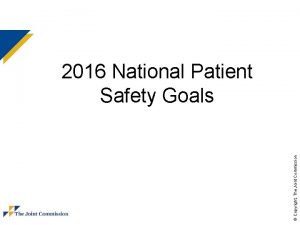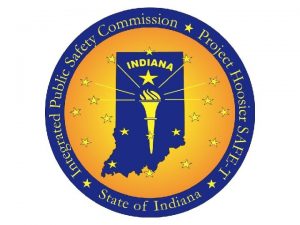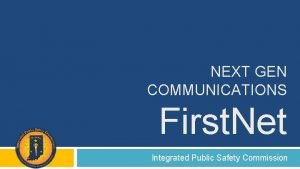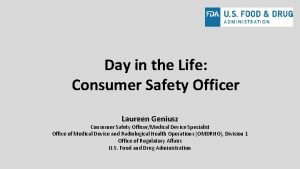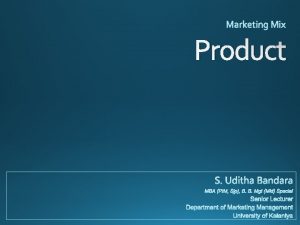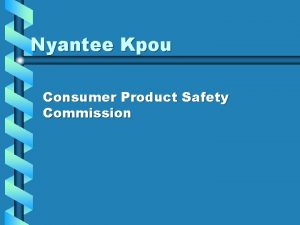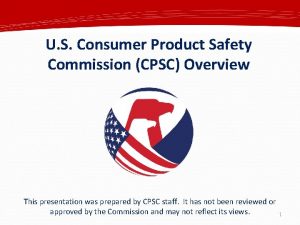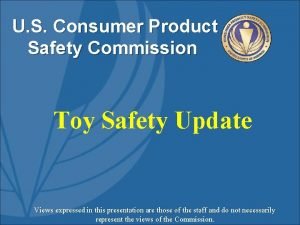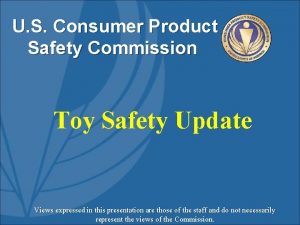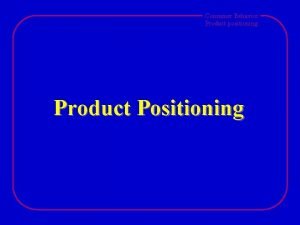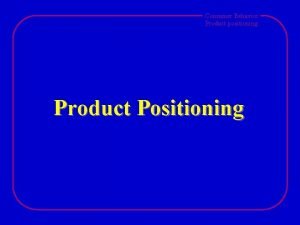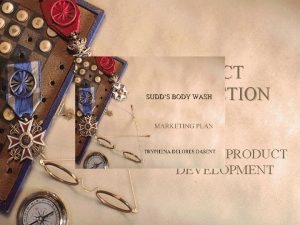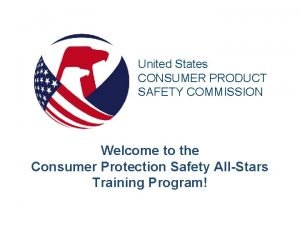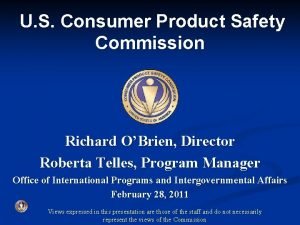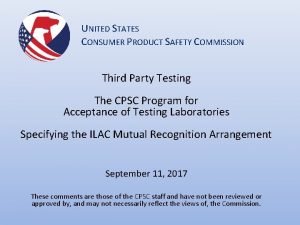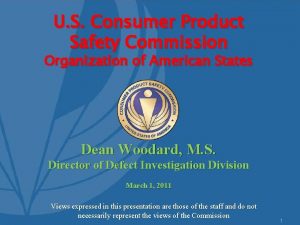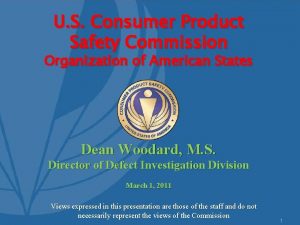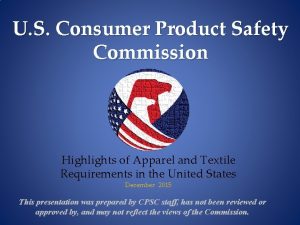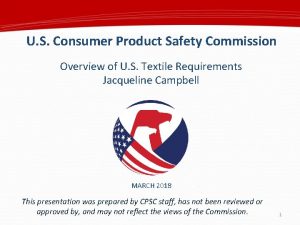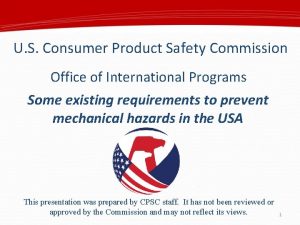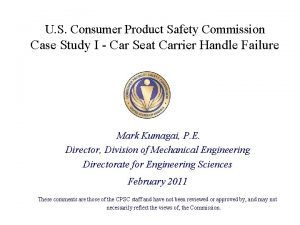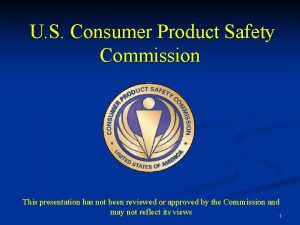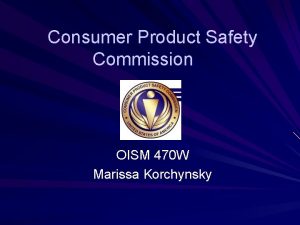The U S Consumer Product Safety Commission CPSC












































- Slides: 44

The U. S. Consumer Product Safety Commission CPSC - An Overview February 28, 2011 This presentation was prepared by CPSC staff. It has not been reviewed or approved by, and may not necessarily reflect the views of, the Commission.

What is the CPSC? � Independent regulatory agency � Commission � Mission to protect consumers

The CPSC � Five Commissioners › Appointed by the President › Confirmed by the Senate � Budgeted staffing level of 576 � Annual budget of $118 M

The CPSC Commission Inez Tenenbaum Chairman Thomas Moore Robert Adler Nancy Nord Anne Northup

Operating with a Full Commission � For the first time in 20 years, the Consumer Product Safety Commission is at full strength, with five Commissioners on board. � The Commission is holding frequent public briefings. � The Commission meets weekly on compliance issues, with special topics discussed monthly.

Organizational Structure

Commission Authority � Consumer � Federal Product Safety Act Hazardous Substances Act � Flammable � Poison Prevention Packaging Act � Children’s � Virginia Act Fabrics Act Gasoline Burn Prevention Act Graeme Baker Pool and Spa Safety � Refrigerator Safety Act

Jurisdiction � Jurisdiction over thousands of types of consumer products � Excludes some types of products covered by other federal agencies › › › Automobiles and related equipment (NHTSA) Food, drugs, medical devices, and cosmetics (FDA) Firearms (BATF) Airplanes (FAA) Boats and related equipment (Coast Guard) Pesticides (EPA)

CPSC Mission � Protect the public against unreasonable risks of injury associated with consumer products � Assist consumers in evaluating the comparative safety of consumer products � Develop uniform safety standards for consumer products � Promote research and investigations into the causes and prevention of product-related deaths, illnesses, and injuries

Definition of a Consumer Product � Article or component of an article � Produced or distributed for sale � For personal use, consumption, or enjoyment � Residential, school, recreational, or other environment

Risk Management Safe Manufacture and Use • Identify and monitor trends • Educate on safe use • Educate on manufacturing for safety and compliance Domestic Compliance • • • Facility inspections Product inspections Case development Forensic analysis Business intelligence Import Compliance • • Prearrival targeting Case development Forensic analysis Business intelligence CPSC Resources and Processes Business processes, technology, and data Resources aligned with business processes that support information sharing and to drive achievement of objectives coordinated effort

Key CPSIA Requirements

What Requirements Apply to Children’s Products? � For children’s products, there are three CPSC requirements that generally apply: › CPSIA section 101 lead content limits. › CPSIA section 102 certification must be based on testing by recognized third party test labs. › CPSIA section 103 tracking label requirements apply to product and packaging.

Lead Content Limits CPSIA section 101 � 300 parts per million (ppm) limit applies to all accessible components of children’s products, effective 8/14/2009. � CPSC issued guidance on determining whether a part is accessible in August 2009. � The Commission has approved higher limits for certain electronic parts. � To date, the Commission has not granted any other exclusions from the lead limits.

Lead “Determinations” � The determinations identify materials whose lead content will not exceed 100 ppm. � Apply primarily to natural materials, such as dyed and undyed textiles (cotton, wool), wood (and paper), precious and semiprecious stones. � Do not include metal or plastic fasteners; such as buttons, screws, grommets, or zippers used in apparel or elsewhere. � Final rule issued August 2009.

Certification to Lead Limits � Most children’s products do not have to be certified to the lead content limits yet; they will have to be certified if they are manufactured after 12/30/2011. � EXCEPTION: items of children’s metal jewelry must be certified to the 300 ppm lead content limit if they are manufactured after 8/14/2009.

Limit for Lead in Paint CPSIA section 101(f) 90 ppm limit took effect on 8/14/09 � Applies to the same items as previously under 16 C. F. R. part 1303: � › Paint sold to consumers as such, › Toys and other articles intended for children bearing paint or other surface coating; and › Household furniture bearing paint or other surface coating. � Children’s products manufactured after 8/14/09 must be certified to the 90 ppm limit if they bear paint or a similar surface coating.

Certification - CPSIA section 102 � Most consumer products that are subject to mandatory standards or bans must be certified to be in compliance with each applicable requirement. › Products made in the USA: manufacturer must certify › Products made elsewhere: importer must certify � Children’s products must be certified based on testing by a recognized third-party test lab.

CPSC-Recognized Laboratories � Third-party � Firewalled � Governmental

325 CPSC-Recognized CABs Located in 33 Countries 2/1/2011

PRC/Hong Kong 95 325 CPSC-Recognized CABs Located in 33 Countries 2/1/2011

USA 85 325 CPSC-Recognized CABs Located in 33 Countries 2/1/2011

India 19 325 CPSC-Recognized CABs Located in 33 Countries 2/1/2011

Germany 13 325 CPSC-Recognized CABs Located in 33 Countries 2/1/2011

Taiwan 12 325 CPSC-Recognized CABs Located in 33 Countries 2/1/2011

United Kingdom 11 325 CPSC-Recognized CABs Located in 33 Countries 2/1/2011

Italy 10 325 CPSC-Recognized CABs Located in 33 Countries 2/1/2011

Austria Bangladesh Belgium Brazil Canada Denmark France Mexico Pakistan Peru Philippines Portugal Singapore South Korea All Others 80 Greece Guatemala Indonesia Japan Malaysia Mauritius 325 CPSC-Recognized CABs Located in 33 Countries 2/1/2011 Spain Sri Lanka Switzerland Thailand Turkey Vietnam

Finding Recognized Test Labs � To issue a valid certificate, you must be sure that testing is performed by a recognized thirdparty test lab. › Not all accredited labs are recognized. � All recognized labs are listed on the CPSC’s website with their approved scope. › A lab may be approved by the CPSC for one standard but not another. � You can also search for recognized labs nearest your location.

Tracking Labels CPSIA section 103 Children’s products manufactured on or after August 14, 2009, must have permanent distinguishing marks on the product and packaging “to the extent practicable. ” � Manufacturers and importers are responsible. � Marks must allow consumers to ascertain: � › the manufacturer or private labeler; › the date and place of production; and › cohort information.

Tracking Label Guidance Statement of Policy issued July 2009 � Interprets basic requirements, such as when product or packaging should be marked, how permanent the marks should be, and how specific the dates and places of manufacture should be � Does not require all information on one label � No size or font requirements � Does not require creation of batch or lot system, but you need some method of tracking parts �

Durable Nursery Products CPSIA section 104 � Twelve classes are identified by statute, › Others have been identified by staff. � CPSC must promulgate mandatory standards for all of these (two every six months). � For durable nursery products, the manufacturer also must provide product registration cards and keep records of consumers who register.

Durable Nursery Products CPSIA section 104 � Section 104 requires the CPSC to issue at least two new standards every six months. › › › Final Rule for Cribs – December 2010 Final Rule for Bassinets – Spring 2011 Final Rule for Toddler Beds – Spring 2011 Proposed Rule for Swings – Spring 2011 Proposed Rule for Bed Rails – Spring 2011

Product Registration Cards CPSIA section 104 � Required for all categories of durable infant and toddler products � Final rule issued on December 29, 2009 › Correction issued on February 22, 2010

Mandatory Toy Standards CPSIA section 106 � Most provisions of ASTM F-963 -07 became mandatory for toys made after February 10, 2009. � Most provisions of ASTM F-963 -08 became mandatory for toys made after August 17, 2009 (except deletion of toy box provision).

Child Care Articles � Includes items designed or intended for children age three and younger to facilitate sleep or feeding or to help such children with sucking or teething � Limit is 1, 000 parts per million for six specific phthalates › DEHP, DBP, BBP – Prohibited › DINP, DIDP, Dn. OP – Interim Prohibition

Toys and Phthalates � Children’s toys are subject to 1, 000 ppm limit on the three banned phthalates. � Toys that can be mouthed are subject to 1, 000 ppm limit on the three additional phthalates.

Phthalates CPSIA section 108 � Revised test method focuses on concentration in each plasticized component rather than the entire product � Unlike the lead provision, phthalate section lacks an exception for inaccessible components � Commission enforcement focus remains on items of greatest risk

Content of Certificates � All certificates of conformity must: › identify the manufacturer or importer issuing the certificate and any third party on whose testing the certificate depends, by name, address, and phone number �Note: not required to name a foreign manufacturer › specify each applicable standard, ban, etc. › spell out the date and place where the product was manufactured and date and place of testing › show contact information for person maintaining test records

Availability of Certificates � Certificates must “accompany” each product or shipment of products covered by the same certificate. � A copy of the certificate must be “furnished to each distributor or retailer of the product” (no requirement to provide to ultimate consumer). � A copy of the certificate must be made available to the Commission and Customs upon request.

Electronic Certificates � The Commission by rule has confirmed that certificates in electronic form are acceptable. � Key requirements: › Certificate must be created no later than the time of shipment to the United States or first distribution within the United States. › The certificate must be reasonably accessible from information on the product or accompanying the shipment; it can be transmitted with Customs docs.

Certification vs. Compliance Certification never exempts any product from the requirement to comply with an applicable rule, standard, ban, or regulation. � Manufacturers (including importers), distributors, and retailers must report to the CPSC immediately if they learn that one of their products fails to comply with an applicable rule. � A person holding a certificate of compliance may have a defense in a noncompliance case. �

Watch for More Certification Guidance �More lab accreditation rules �Component testing rule �Program for voluntary certification marks on consumer products �Testing Rule �Reasonable testing program �Periodic testing requirements �Random testing requirements �Verification of compliance �Safeguards against undue influence over labs

Robert Howell rhowell@cpsc. gov
 Food chain vs food web
Food chain vs food web Defects of the present curriculum
Defects of the present curriculum Graduated commission jobs
Graduated commission jobs Herbivores in the sahara desert
Herbivores in the sahara desert Consumer diversity in consumer behaviour
Consumer diversity in consumer behaviour Consumer research process
Consumer research process Black box model consumer behaviour
Black box model consumer behaviour Business buyer behavior refers to the
Business buyer behavior refers to the National patient safety goal 6
National patient safety goal 6 Integrated public safety commission
Integrated public safety commission Integrated public safety commission
Integrated public safety commission Consumer safety officer
Consumer safety officer Product augmentation
Product augmentation Convenience goods shopping goods specialty goods
Convenience goods shopping goods specialty goods Hát kết hợp bộ gõ cơ thể
Hát kết hợp bộ gõ cơ thể Ng-html
Ng-html Bổ thể
Bổ thể Tỉ lệ cơ thể trẻ em
Tỉ lệ cơ thể trẻ em Chó sói
Chó sói Chụp tư thế worms-breton
Chụp tư thế worms-breton Hát lên người ơi
Hát lên người ơi Kể tên các môn thể thao
Kể tên các môn thể thao Thế nào là hệ số cao nhất
Thế nào là hệ số cao nhất Các châu lục và đại dương trên thế giới
Các châu lục và đại dương trên thế giới Công của trọng lực
Công của trọng lực Trời xanh đây là của chúng ta thể thơ
Trời xanh đây là của chúng ta thể thơ Mật thư anh em như thể tay chân
Mật thư anh em như thể tay chân Phép trừ bù
Phép trừ bù độ dài liên kết
độ dài liên kết Các châu lục và đại dương trên thế giới
Các châu lục và đại dương trên thế giới Thể thơ truyền thống
Thể thơ truyền thống Quá trình desamine hóa có thể tạo ra
Quá trình desamine hóa có thể tạo ra Một số thể thơ truyền thống
Một số thể thơ truyền thống Cái miệng bé xinh thế chỉ nói điều hay thôi
Cái miệng bé xinh thế chỉ nói điều hay thôi Vẽ hình chiếu vuông góc của vật thể sau
Vẽ hình chiếu vuông góc của vật thể sau Thế nào là sự mỏi cơ
Thế nào là sự mỏi cơ đặc điểm cơ thể của người tối cổ
đặc điểm cơ thể của người tối cổ Thế nào là giọng cùng tên?
Thế nào là giọng cùng tên? Vẽ hình chiếu đứng bằng cạnh của vật thể
Vẽ hình chiếu đứng bằng cạnh của vật thể Fecboak
Fecboak Thẻ vin
Thẻ vin đại từ thay thế
đại từ thay thế điện thế nghỉ
điện thế nghỉ Tư thế ngồi viết
Tư thế ngồi viết Diễn thế sinh thái là
Diễn thế sinh thái là








